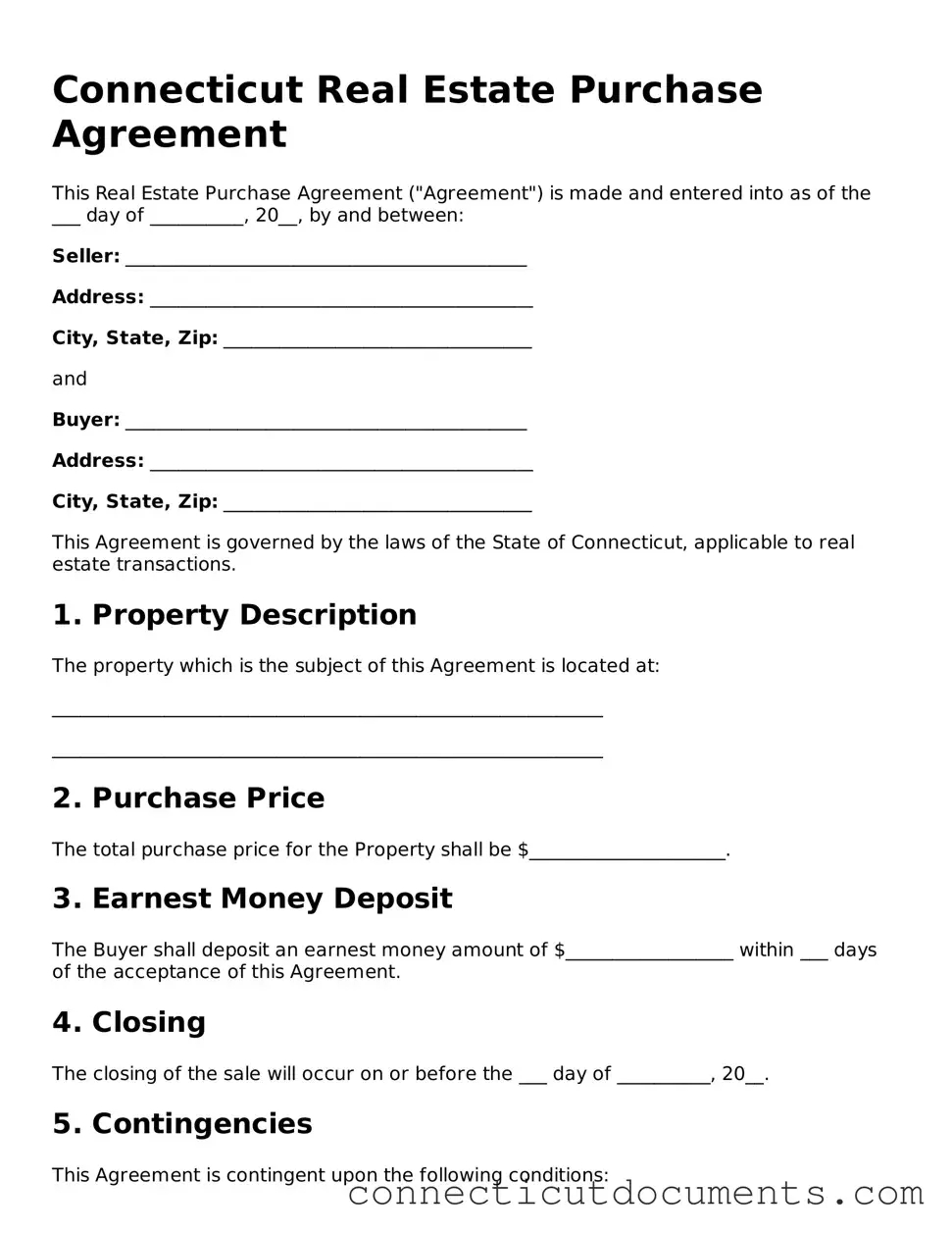The Connecticut Real Estate Purchase Agreement form shares similarities with the Residential Purchase Agreement, which is commonly used in various states. Both documents outline the terms and conditions under which a buyer agrees to purchase a property from a seller. They typically include essential elements such as the purchase price, closing date, and contingencies, ensuring that both parties have a clear understanding of their obligations and rights throughout the transaction process.
Another document that resembles the Connecticut Real Estate Purchase Agreement is the Commercial Purchase Agreement. While primarily used for commercial properties, this agreement also details the terms of sale, including price and conditions. Both agreements aim to protect the interests of buyers and sellers, although the commercial version may include additional clauses addressing zoning laws and business operations, reflecting the complexities of commercial real estate transactions.
The Option to Purchase Agreement is another document akin to the Connecticut Real Estate Purchase Agreement. This agreement grants the buyer the right, but not the obligation, to purchase the property within a specified timeframe. Similar to the Real Estate Purchase Agreement, it includes terms regarding price and duration. However, it differs in that it allows for flexibility, giving buyers the chance to evaluate the property before committing to a purchase.
The Lease Purchase Agreement also bears resemblance to the Connecticut Real Estate Purchase Agreement. This document combines elements of leasing and purchasing, allowing a tenant to rent a property with the option to buy it later. Like the Real Estate Purchase Agreement, it outlines the purchase price and terms, but it also includes lease terms, making it a hybrid agreement that serves dual purposes.
The Seller Financing Agreement is another document that shares characteristics with the Connecticut Real Estate Purchase Agreement. In this arrangement, the seller provides financing to the buyer, allowing them to purchase the property directly. Both agreements contain key terms such as the purchase price and payment schedule, but the Seller Financing Agreement will also detail the interest rate and repayment terms, reflecting the financial arrangement between the parties.
The Land Contract, also known as a Contract for Deed, is similar to the Connecticut Real Estate Purchase Agreement in that it allows a buyer to make payments directly to the seller while taking possession of the property. This document outlines the purchase price, payment terms, and conditions of sale. Unlike traditional purchase agreements, the seller retains the title until the buyer fulfills all payment obligations, providing a unique structure for the transaction.
The Real Estate Sales Agreement is another document that aligns closely with the Connecticut Real Estate Purchase Agreement. This agreement serves as a binding contract between the buyer and seller, detailing the terms of sale, including price and contingencies. Both documents aim to facilitate a smooth transaction and provide clarity on the responsibilities of each party involved in the sale.
The Purchase and Sale Agreement is also comparable to the Connecticut Real Estate Purchase Agreement. This document outlines the sale of real estate and includes essential details such as purchase price, closing date, and contingencies. Both agreements serve the same fundamental purpose of formalizing the transaction, ensuring that both parties are aware of their rights and obligations throughout the process.
For those navigating the New York rental market, utilizing a comprehensive Rental Application form is essential to streamline the tenant selection process. Landlords benefit greatly from this enforced clarity, as it ensures they gather all necessary information for assessment, ultimately contributing to better tenant-landlord relationships. For an easy-to-use template, you can refer to NY PDF Forms, which provides a structured approach to completing this crucial documentation.
Lastly, the Exclusive Right to Sell Agreement shares similarities with the Connecticut Real Estate Purchase Agreement. This document is typically used by real estate agents to secure a listing. While it focuses on the seller's commitment to work with a specific agent, it also outlines the terms of sale and can include provisions related to the eventual purchase agreement. Both documents are integral to the real estate transaction process, emphasizing the importance of clear communication and defined expectations.
